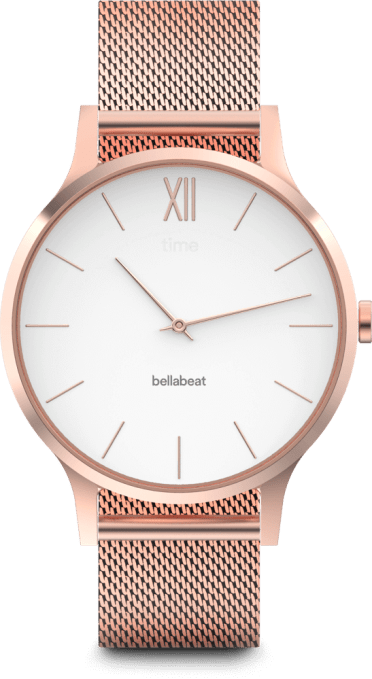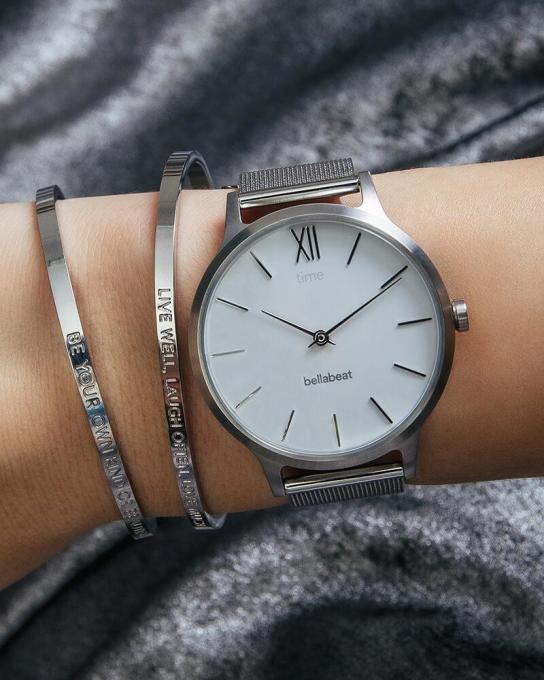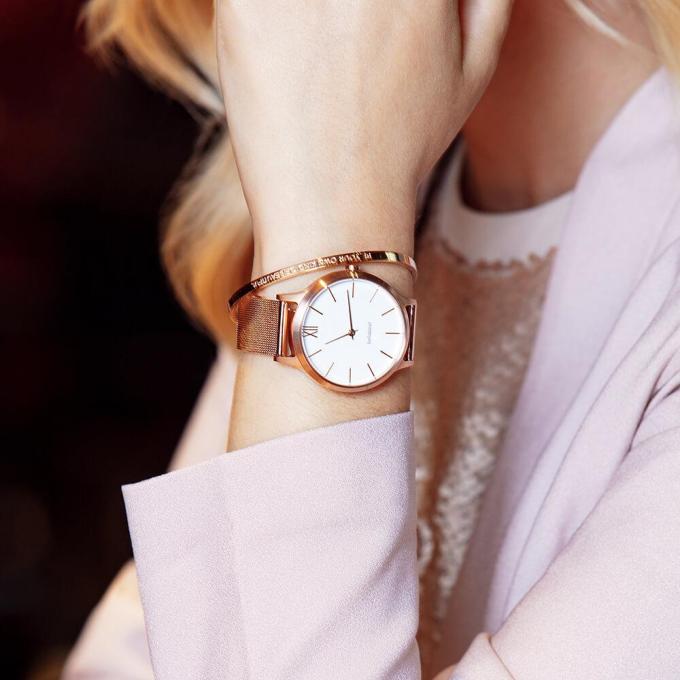Bellabeat’s new hybrid smartwatch tracks your stress…and goes with your outfit
Bellabeat, the company behind a variety of health and wellness wearable devices aimed at women, is now selling its first smartwatch. The device, which is simply called “Time,” was announced earlier this month right in the midst of holiday shopping season. Like other fitness trackers, the watch is capable of basic tasks like counting your steps, tracking sleep patterns and reminding you to move. But unlike traditional smartwatches — which, aesthetically, are still very much just a screen on your wrist — the Time is designed to look like jewelry.
The hybrid device looks like a watch — albeit not a very expensive one.
It’s squarely in the range of fashion jewelry, with either silver or rose gold stainless steel finishes to choose from, and a minimalist watch face that forgoes complications like the date or the moon phase, for example. It even lacks a second hand.
That said, I prefer its cleaner look-and-feel to the gaudier smartwatches put out by brands like Michael Kors and Fossil. (Plus, there’s no Android Wear/Wear OS to contend with here.)
As an analog watch, it has both its pros and cons.
It’s designed to be hypoallergenic so as not to irritate those with sensitive skin, and it has some water resistance. (ATM grade 3, meaning it can withstand a vigorous hand washing and the rain. You can’t swim, bathe or dive with it.)
 You also don’t have to charge it, which makes it feel more like a “real” watch than a gadget.
You also don’t have to charge it, which makes it feel more like a “real” watch than a gadget.
However, there’s a potential downside here, too — the coin cell battery only lasts “up to” six months. You’ll then need to use the tiny tool it ships with to replace the old battery with a new one.
Of course, some will see a user-replaceable battery as a perk. I don’t, but that’s a personal preference on my part.
I much prefer just dropping my Apple Watch onto a charger rather than having to keep up with a small watch tool, which can be easy to lose or misplace in the time between repairs. I’m also not a fan of having to unscrew tiny screws and then finding some sort of small, sharp object to pop out the battery. Perhaps that’s because I have a child with a dozen or so battery-operated toys. I’m constantly unscrewing things to replace batteries, and frankly I don’t need another.
In any event, among the watch’s better aspects is the fact that it packages up fitness and wellness tracking in a device that passes as a regular — and even fairly attractive — piece of fashion jewelry. The Time will go better with some of your outfits where you just don’t think the Apple Watch works — even with one of Apple’s fancier bands.
Of course, it’s not as seamless to use Time as the Apple Watch, which has the Apple platform advantage. (Or an Android smartwatch paired with an Android phone, for that matter.)
Instead, you have to sync your activity between the watch and the third-party Bellabeat app to view things like the steps taken or hours slept. You do so by tapping a sync button in the app and double-tapping on the watch face.

The app can also serve as way to keep up with other aspects of your health and wellness, including your hydration goals, stress, meditation time and your period.
The stress metrics are calculated for you, based on factors like activity levels, sleep quality, reproductive health and meditation over the past week. But hydration and menstruation have to be logged manually (*unless you’re using Bellabeat Spring — see below.)
The mediation tracking only calculates your progress through the app’s own selection of more than 30 included exercises. While it’s nice to have access to those resources included in the app, many people are already using popular meditation apps like Calm or Headspace. An “import” option for externally logged “mindful minutes” would have been nice here.
One of Time’s better features are its silent alarms and inactivity alerts. Instead of pings and loud noises, the watch more calmly reminds you of things with vibrations you configure. There are also included alarms for waking up, taking your vitamins, taking your contraception pill and another general alarm setting, each with their own toggle switches and settings.

There is something to be said for a quieter smartwatch, especially if stress levels are a concern. (There’s also something to be said for a device that’s built by a woman with the needs of women in mind. Remember how long it took for Apple to realize period tracking was a thing?)
That said, it’s unfortunately becoming harder for smaller device makers to compete with the Apple Watch, which has now moved into advanced areas with its Series 4 line, with sports, life-saving ECG and fall detection features, along with smarter workout detection (and yes, you can still swim with it), plus its ability to work with the broader iOS app ecosystem in a more native way.
But the Apple Watch is pricier at $399 and up for current models. Bellabeat’s Time, by comparison, is $179.
The Bellabeat mobile app will work with other Bellabeat products, including its wellness tracker Leaf (which can be worn as a bracelet, necklace, clip, etc.), and $59 smart water bottle, Spring.
Combined, the Spring and Time could be a good entry point into the world of fitness and wellness trackers for those who never felt that wearables and trackers were right for them. Bellabeat’s line is more of a lifestyle choice based just as much on looks as on tech, if not more so.
The question now is whether or not Bellabeat can carve out a big enough slice of the smartwatch market, which continues to be dominated by Apple, to sustain itself in the years ahead.
Bellabeat was a Y Combinator 2014 grad founded by female entrepreneur Urska Srsen, and has raised ~$19 million to date, according to Crunchbase. It previously sold products for expectant mothers, as well, but those have been phased out. Bellabeat declined to share any user metrics or revenue figures, when asked.